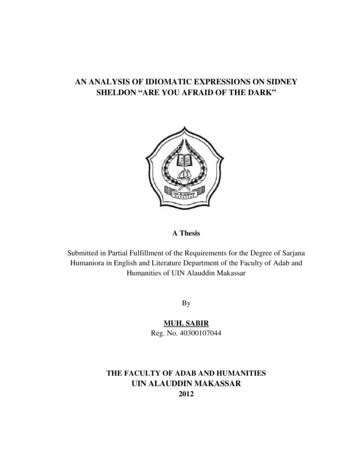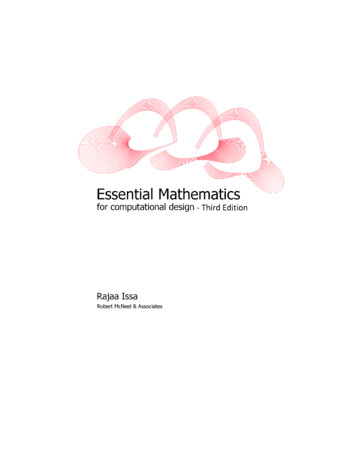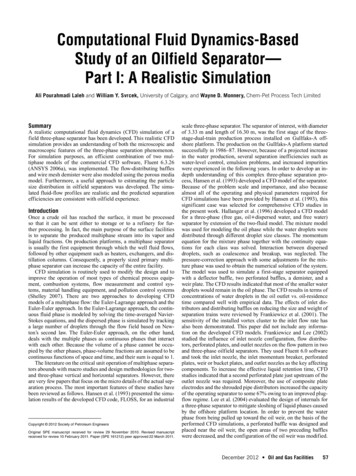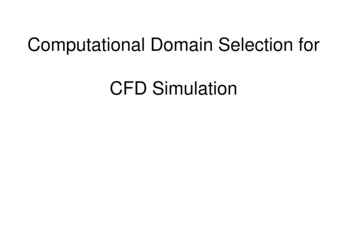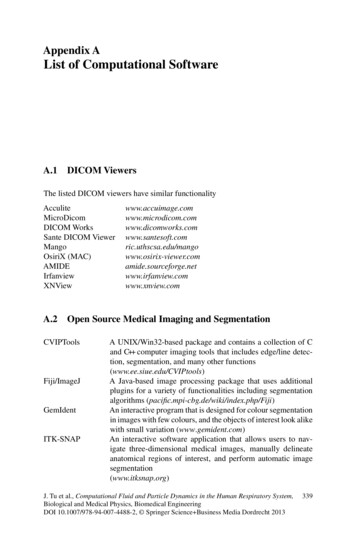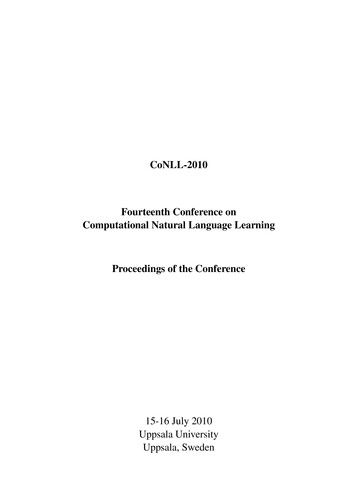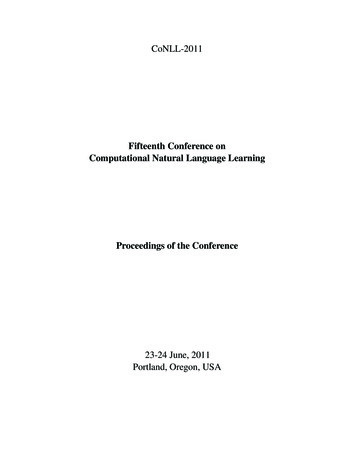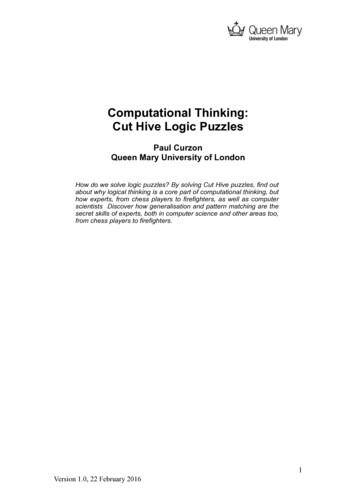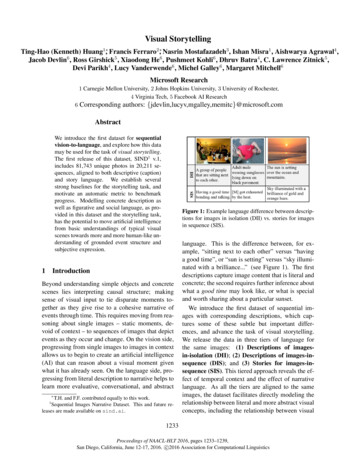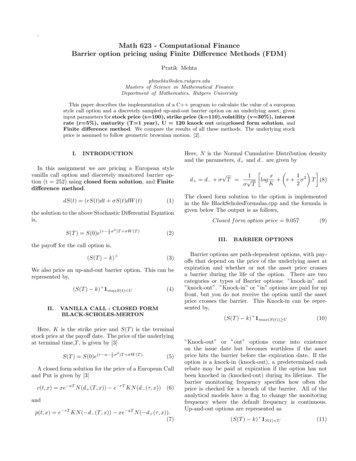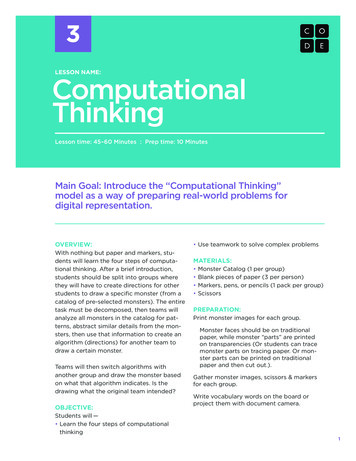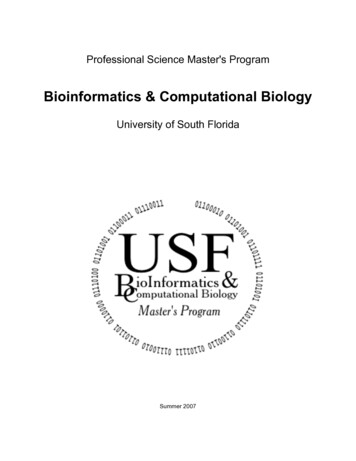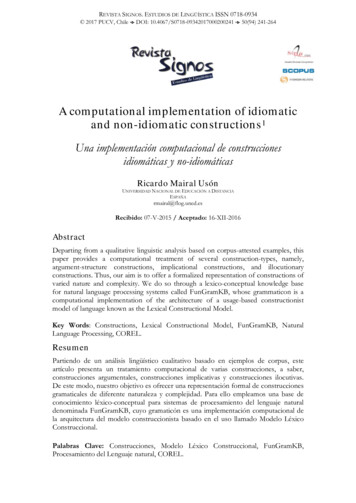
Transcription
REVISTA SIGNOS. ESTUDIOS DE LINGÜÍSTICA ISSN 0718-0934 2017 PUCV, Chile DOI: 10.4067/S0718-09342017000200241 50(94) 241-264A computational implementation of idiomaticand non-idiomatic constructions 1Una implementación computacional de construccionesidiomáticas y no-idiomáticasRicardo Mairal UsónUNIVERSIDAD NACIONAL DE EDUCACIÓN A DISTANCIAESPAÑArmairal@flog.uned.esRecibido: 07-V-2015 / Aceptado: 16-XII-2016AbstractDeparting from a qualitative linguistic analysis based on corpus-attested examples, thispaper provides a computational treatment of several construction-types, namely,argument-structure constructions, implicational constructions, and illocutionaryconstructions. Thus, our aim is to offer a formalized representation of constructions ofvaried nature and complexity. We do so through a lexico-conceptual knowledge basefor natural language processing systems called FunGramKB, whose grammaticon is acomputational implementation of the architecture of a usage-based constructionistmodel of language known as the Lexical Constructional Model.Key Words: Constructions, Lexical Constructional Model, FunGramKB, NaturalLanguage Processing, COREL.ResumenPartiendo de un análisis lingüístico cualitativo basado en ejemplos de corpus, esteartículo presenta un tratamiento computacional de varias construcciones, a saber,construcciones argumentales, construcciones implicativas y construcciones ilocutivas.De este modo, nuestro objetivo es ofrecer una representación formal de construccionesgramaticales de diferente naturaleza y complejidad. Para ello empleamos una base deconocimiento léxico-conceptual para sistemas de procesamiento del lenguaje naturaldenominada FunGramKB, cuyo gramaticón es una implementación computacional dela arquitectura del modelo construccionista basado en el uso llamado Modelo LéxicoConstruccional.Palabras Clave: Construcciones, Modelo Léxico Construccional, FunGramKB,Procesamiento del Lenguaje natural, COREL.
INTRODUCTIONThe family of Construction Grammars (CxG(s)) comprises a number ofcompatible approaches, among which we find the following (Hoffmann & Trousdale,2013): 'Cognitive CxG' (Goldberg, 2006); 'Frame-Semantic CxG' (Boas, 2011); and'Cognitive Grammar' (Langacker, 1987). In general, even though these accounts differin their theoretical orientation towards particular issues, most of them share importantunderlying assumptions (Goldberg, 2013). One point of consensus among the abovelisted proposals revolves around the understanding of the notion of linguistic'construction' as an entrenched form-meaning pairing, which, for any language, is partof a network of form-function correspondences (the so-called 'constructicon')featuring diverse construction-types at different levels of complexity and abstraction.A non-exhaustive inventory includes widely studied argument-structure constructionslike the ditransitive (e.g. Scott sent Mary a book), resultative (e.g. The river frozesolid), and caused-motion (e.g. The audience laughed the actor off the stage). Aboveand below the sentence level, conventionalized pieces of language such as ‘Hello?! X’(e.g. Hello?! Are you even listening to me?; Google Books American Corpus (GBAC),2006), ‘What’s X Doing Y?’ (e.g. What’s he doing with your money?; GBAC, 2007),‘Could you Y?’ (e.g. Could you please hand me that pillow?; GBAC, 2005), ‘Let alone’(e.g. We do not hear about her being able to read, let alone speak; GBAC, 2007), toname a few, also count as constructions.Within the family of CxGs, a specific group of approaches, collectively called‘computational CxGs’, includes: ‘Embodied CxG’ (Bergen & Chang, 2013), 'SignBased CxG' (Boas & Sag, 2012), and ‘Fluid CxG’ (Steels, 2012). Although theseapproaches are concerned with providing formalized representations of linguisticconstructions, most of the work has so far been devoted to argument-structureconstructions such as the caused-motion and the ditransitive (e.g. Sag, 2011; van Trijp,2011; Steels & van Trijp, 2011; Dodge & Petruck, 2014). Similarly, FrameNet, whoseaim is “to document the range of semantic and syntactic combinatory possibilities (i.e.valences) of each lexical item” (Ruppenhofer, Ellsworth, Petruck, Johnson &Scheffczyk, 2010: 5), is also building computer-based Constructicons for differentlanguages (Fillmore, 2006, 2008; Fillmore, Lee-Goldman & Rhomieux, 2012; Sato,2012; Torrent, Meireles, Fernandes, Da Silva & Da Silva, 2014). As will be shown, inthe FrametNet English Constructicon, which appears to still be work in progress, thetreatment of grammatical constructions is inconsistent in some cases.In this context, the present paper contributes to this ongoing research program byproviding readers with a computational treatment of constructions that exist atdifferent levels of linguistic enquiry. More concretely, our formalized analysis of arepresentative sample of construction-types departs from a previous qualitativelinguistic analysis, which, in line with the usage-based approach, is grounded in acareful examination of corpus-attested examples extracted from systematic searchers242RICARDO MAIRAL USÓN
within the GBAC at http://googlebooks.byu.edu/x.asp In so doing, we make use of alexico-conceptual knowledge base for Natural Language Processing (NLP) systemscalled FunGramKB (Periñán, 2013), whose Grammaticon is a computationalimplementation of the usage-based constructionist model known as the ‘LexicalConstructional Model’ (Ruiz de Mendoza, 2013; Ruiz de Mendoza & Galera, 2014).The LCM differs from other constructionist accounts (Goldberg, 1995; Goldberg &Jackendoff, 2004, inter alios), since, in this model, grammatical constructions of variedformal and functional complexity are parsimoniously assigned different places andfunctions within the same architecture. Such a holistic design is suitable for acomputational environment that seeks to include both the propositional and the nonpropositional dimensions of meaning. Thus, the LCM distributes heterogeneousconstructions across four levels of meaning representation, each of which iscomputationally implemented in the Grammaticon of FunGramKB: level 1 deals withargument-structure constructions (e.g. He looked for a metal pipe and hammered itflat on one end (GBAC, 2013)), level 2 address implicational constructions (e.g. Don’tyou honey me!; GBAC, 2007), level 3 focuses on illocutionary constructions (e.g. Canyou open the door?; GBAC, 2001), and level 4 is concerned with discourse structure(e.g. Just because I forgive you doesn’t mean I forget; GBAC, 2014). In this paper weshall analyze level-1, 2 and 3 constructions from a computational perspective, thuscontributing to the formalization of constructions of different formal and functionalnature.With this in mind, the structure of this paper is as follows. Sections 1 describes thenature, linguistic basis and architecture of FunGramKB. For comparative purposes,Section 2, which is devoted to the Grammaticon, first addresses the treatment ofgrammatical constructions in another knowledge base, i.e. FrameNet. In turn, Sections2.1, 2.2 and 2.3 respectively focus on argument-structure constructions, implicationalconstructions and illocutionary constructions. In each of these subsections we providea constructionist or LCM-based analysis of such construction-types, to thenconcentrate on a formalized representation of their semantics.1. FunGramKBFunGramKB is a user-friendly online environment for the semiautomaticconstruction of a multipurpose lexico-conceptual knowledge base for NLPsystems(see www.fungramkb.com and the publications uploaded therein). First,FunGramKB is semiautomatic since it combines automatic processes (e.g.information in DBPedia is imported onto the Onomasticon) with highly timeconsuming tasks such as the manual formalization of knowledge. Second,FunGramKB is multipurpose given its multifunctional and multilingual nature. Thatis, on the one hand, FunGramKB has been originally designed to be reused in otherNLP tasks, and in particular, in those that focus on language understanding (e.g.REVISTA SIGNOS. ESTUDIOS DE LINGÜÍSTICA 2017, 50(94)243
machine translation, dialogue-based systems, information retrieval and extraction,etc.). Despite the relative youth of the project, there are already a number of differentnatural language applications, e.g. Discovering and Extracting Terminology(DEXTER) and Data Mining Encountered (DAMIEN) (see www.fungramkb.com).On the other, FunGramKB faces the challenge of developing a multilingual tool thatcurrently includes several western languages (e.g. Spanish, English, Italian, French,German, etc.). Most of the effort, however, has focused on the development ofEnglish and Spanish. Thus, work on the rest of languages is on its early stages.As far the theoretical framework is concerned, FunGramKB proponents departfrom the assumption that although it is easier to build operative NLP systems that donot rely on a given linguistic theory, such systems fail from a semantic point of view(Raskin, 1987). Thus, in order to avoid deceptively intelligent NLP systems and allownatural language understanding instead, it is argued that a linguistic theory must lie atthe heart of the computational system. This is also the case of ‘Frame Semantics’(Fillmore, 1982) in FrameNet, for example. In FunGramKB this premise translates asfollows. The lexical and grammatical knowledge levels, also called Lexicon andGrammaticon, are respectively grounded in two largely compatible linguistic theories.On the one hand, the Lexicon is based on the functional theory of language known asRole and Reference Grammar (RRG) (Van Valin & LaPolla, 1997; Van Valin, 2005).This model, which was not devised for computational linguistics, is nevertheless usefulfor text meaning representation (Periñán & Arcas, 2014). On the other, theGrammaticon, which also incorporates core aspects of RRG, is inspired in thearchitecture of the LCM. The explanation behind the introduction of such aconstructionist model in FunGramKB has to do with the fact that RRG-basedapproaches to grammatical constructions are highly underdeveloped (Nolan, 2011,2014). Consequently, an adequate computational treatment of meaning constructioncalled for the incorporation of a constructionist model which already includes within asingle architecture all levels of linguistic enquiry.The following section describes the architecture of FunGramKB in more detail.1.1. ArchitectureFunGramKB comprises three major knowledge levels that consist of severalindependent, yet related, modules:(i) The 'conceptual level' is language-independent and is therefore shared by all thelanguages currently supported in the knowledge base. This level is made up of threesub-modules, all of which employ the same formal language (i.e. COREL; Periñán &Mairal, 2010) to codify knowledge:- The Cognicon stores procedural knowledge by means of scripts (e.g. ‘going to arestaurant’).244RICARDO MAIRAL USÓN
- The Onomasticon keeps information about instances of entities and events (e.g.9/11, Mozart, Eiffel Tower).- The Ontology, which stores semantic knowledge, takes the form of ahierarchical or IS-A structured catalogue of conceptual units. 2 This componentfunctions as the pivot around which the whole resource revolves. In theOntology, concepts, to which word senses are connected, are provided withsemantic properties in the form of one ‘Thematic Frame’ (TF) and one‘Meaning Postulate’ (MP). It should be noted that both TFs and MPs aretreated as conceptual schemata, since they actually employ concepts (instead ofwords) as the building blocks for the formal description of meaning (Periñán,2013). A TF states the number and type of participants involved in an event.Partially inspired in Halliday’s (1985) and Dixon’s (1991) work, participants inFunGramKB, also called ‘thematic roles’, are expressed through indexedvariables (e.g. (x1), (x2), etc.), and their nature may be constrained by conceptsthat work as ‘selectional preferences’ (e.g. CORPUSCULAR 00 in (1)). Forexample, the TF of the concept TEAR 01 in (1) is the following:(1) TF: (x1)Theme (x2: CORPUSCULAR 00)Referent ‘An unspecifiedentity (x1) tears a tridimensional object or (x2)’In turn, MPs are sets of one or more logically connected predications (e1, e2, e3,etc.) that carry the generic features of concepts. Consider the MP of the concept TEAR 01, which inherits from its superordinate concept BREAK 00. Thesemantics of the lexical units 'tear', 'tear off', 'rip', Spanish rasgar, despedazar, Italianstrappare, etc., are related to TEAR 01, or to put in other words, TEAR 01 islexicalized by one sense of each of these lexical items. The formalized representationof TEAR 01 via the COREL metalanguage is given in (2):(2) MP: (e1: BREAK 00 (x1)Theme (x2)Referent (f1: FAST 00)Speed (f2: HARD 00)Manner) ‘to tear means that an entity (x1) breaks an object(x2) quickly and violently’.(ii) The 'lexical level' covers what is commonly referred to as linguistic knowledge,which is language-dependent. All lexical units in the Lexica are connected to a conceptin the Ontology (e.g. 'rip' in TEAR 01), from which they get their conceptualdefinition. This is similar to FrameNet’s approach, in which, as is shown below,semantically lexical units evoke frames. Additionally, each lexical unit is individuallydefined in its corresponding Lexicon. In turn, the role of the Morphicon is to handlecases of inflectional morphology.(iii) Finally, the 'grammatical level', to which we devote ourselves in Section 2, is alsolanguage-specific. This level stores constructional schemata thereby helping RRG tobuild the semantics-to-syntax algorithm. 3REVISTA SIGNOS. ESTUDIOS DE LINGÜÍSTICA 2017, 50(94)245
2. The Grammaticon: An analysis ofschemas across levels of representationconstructionalThe FunGramKB Grammaticon (Periñán 2013; Periñán & Arcas, 2014; Mairal,2012, 2015; Van Valin & Mairal, 2014; Luzondo & Ruiz de Mendoza, 2015) is thelinguistic module that stores constructional schemata, that is, machine-tractablerepresentations of constructions. It comprises several Constructicons (i.e. L1Constructicon, L2-Constructicon, L3-Constructicon, and L4-Constructicon), which, aspreviously noted, are inspired in the four constructional layers of the LCM. Thereason for this is the aim to endow FunGramKB with the capacity to deal with boththe propositional and non-propositional dimensions of meaning. A similar interest isshared by the FrameNet knowledge base (Baker, 2014), whose English Constructiconalready incorporates structures of varying size and complexity such as 'Let alone' (e.g.'It is difficult enough for an individual to be consistent, let alone a society'),comparison constructions (e.g. 'X is –er than Y'), the ‘way’ construction (e.g. 'Shewhistled her way down the lane'), etc. In order to understand the motivation behindthe inclusion of specific pieces of language in the FrameNet Construction, we need tobriefly describe the lexical resource first.In FrameNet there are two main units of analysis: i.e. frames and lexical units. Aframe is a schematic representations of a situation type (Fillmore, Petruck & Wright,2003b), which can be defined in terms of participants and their functions. Frames areevoked by a set of lexical units (i.e. words taken in one of their senses). This meansthat, as much as it is done in FunGramKB, the separate senses of a polysemous wordare connected to different semantic frames/concepts. Additionally, FrameNet suppliesvalence information, which is specified both semantically and syntactically via thefollowing elements: (i)frame elements (i.e. the entities taking part in the situationdepicted by a given frame), and (ii) phrase types (e.g. NP, PP, etc.) and theircorresponding grammatical functions (Subject, Object, etc.) (Fillmore, Johnson &Petruck, 2003a). Consider the case of the verbal predicate 'tear', which evokes the‘Cause to fragment’ frame, i.e. 'An Agent suddenly and often violently separatesthe Whole patient into two or more smaller Pieces, resulting in the Whole patient nolonger existing as such'. In this frame definition, Agent, Whole patient, and Pieces arecore-frame elements, that is, conceptually prominent components of the frame. Inturn, Manner, Time, Purpose, Result, among others, are non-core frame elements, i.e.those that do not uniquely characterize a given frame, and which usually appear acrossframes. In the lexical entry for 'tear', we are provided with the syntactic patterns inwhich these frame elements occur, that is, with the valence patterns of this lexical unit.For example, in the corpus attested sentence 'One of the men had torn a paper intolittle bits', the Noun Phrases 'one of the men' and 'a paper' and the PrepositionalPhrase 'into little bits' respectively correspond to the frame elements Agent, Wholepatient, and Pieces. Grammatically, these function as Subject (so-called External246RICARDO MAIRAL USÓN
argument), Dependant and Object, respectively. 4 Similarly, in 'With Black againstKarpov it is almost impossible to avoid [ ] the desire to tear Karpov apart with barehands', the Whole patient frame element is realized by the NP 'Karpov', which worksas an Object. The Result frame element is expressed as an Adverbial Phrase ('apart')which also works as a Dependant. As is obvious from these two instances, classicalFrameNet annotations may include realizations of oft-quoted constructions like theresultative. This is possible because the Cause to fragment frame has two frameelements, i.e. Pieces (e.g. 'I smashed the toy boat to flinders') and Result (e.g. 'I brokeit open'), which allow the annotation of different resultative ingredients. As Levin(1993: 101)) notes, however, a wide range of verbs can be found in the resultativeconstruction, and thus, “no specific classes of verbs are identified here”. These are buta few examples illustrating Levin’s statement: 'drink' (e.g. 'John drank himself to death'(GBAC, 2005); 'He drank the glass empty' (GBAC, 2008)), 'cry' (e.g. 'She cried herselfto sleep'; Levin 1993), 'kill' (e.g. 'I killed him dead'; (GBAC, 2004)), 'worry' (e.g. 'She’sworried sick'; (GBAC, 2009)), 'talk' (e.g. 'He talked himself blue in the face';(Goldberg, 1995)), etc. In FrameNet, verbal predicates like 'drink', 'cry', or 'talk' arenot shown to occur in resultative sentences since the frames which each of these verbsevoke do not display some kind of result element that can then be realizedsyntactically. By contrast, 'worry' or 'kill' in ‘Emotion active’ and ‘Killing’ frames,respectively, do list a non-core Result frame element. This kind of inconsistentannotation of constructions could be easily solved by means of including theresultative construction in the English FrameNet Constructicon, which is thus far notpresent in such a component. Note that this solution is fully consistent with Torrentet al.’s (2014) analysis of a Brazilian schematic construction, i.e. the Dative withInfinitive construction, which, like the resultative, is not circumscribed to any givenverb class. These authors show that, when trying to annotate sentences with verbs thatmay occur in such a construction (e.g. 'buy', which evokes the ‘Commerce buy’ frame,or 'have', which evokes the ‘Possession’ frame), constituents that can receive a label inone frame, cannot in another frame. This is so because there is no frame element thatcan be assigned to such a constituent. To account for unlabeled constituents, onecould create specific frame elements in each of the frames in which this situationoccurs. However, Torrent et al. (2014: 41) argue that:“Since several different verbs – evoking several different frames – occurin the Dative with Infinitive construction [ ] a more general andeconomic analytical solution – and also a way to avoid inconsistencies ofhaving analogous linguistic material treated different [ ]– would beincluding the Dative with Infinitive construction in the [ ]Constructicon”.REVISTA SIGNOS. ESTUDIOS DE LINGÜÍSTICA 2017, 50(94)247
In fact, the aim of Torrent et al.’s (2014) work is precisely that of putting forward aset of policies that can help annotators decide what should be accounted for as aninstance of a construction, or as a valence pattern of a lexical unit in the lexicographicdatabase. By contrast, border conflicts in the treatment of specific syntactic structuresdo not pose a problem in FunGramKB in which there is a clearer-cut divisionbetween what goes in the Lexicon and what is part of the Grammaticon.Having pointed out in which way FrameNet and FunGramKB differ in theirmanagement of grammatical constructions, the following sections are devoted to theformalization of levels 1, 2 and 3-constructions in order to show how these arehandled in an NLP environment. 52.1. The L1-ConstructiconThe Grammaticon of FunGramKB is directly connected to the Lexicon, which webriefly presented in Section 1.1. To be more precise, the former is linked to the latterin terms of what has been termed the lexical-grammatical interface (Van Valin &Mairal, 2014). In order to see how lexical units and grammatical constructions interactin FunGramKB, we first devote some space to the Lexicon to then zoom in on thedesign of the L1-Constructicon. To exemplify this, we shall consider the case of theverbal predicate 'rip' and one of the argument-structure construction in which itparticipates, i.e. the transitive ‘apart reciprocal’, as in 'I broke the twig and the branchapart' (Levin, 1993), 'Imperialism rips the governors and the governed apart' (GBAC,2015). In line with Levin, we argue that this grammatical construction, as well as the‘together reciprocal’ construction in 'I creamed the sugar and the butter together'(Levin, 1993), are structural variants of the resultative. In these cases, 'together' and'apart' can function as resultative adverbs because of their secondary-predicationnature. We therefore claim that the ‘together/apart reciprocal’ construction is part ofthe family of the resultative (Goldberg & Jackendoff, 2004), whose members expressresult either in the form of a literal or figurative change of state or as a literal orfigurative change of location (see Ruiz de Mendoza & Luzondo, 2016; Luzondo &Ruiz de Mendoza, 2015).On the one hand, in the Lexicon, the most important component in the case ofverbal predicates is called ‘core grammar’. Here, lexicographers specify the followingelements for the verbal predicate under scrutiny: Aktionsart, variables, macroroleassignment, thematic frame mapping and constructions. 6 These attributes “allow thesystem to build the basic logical structure of verbs automatically” (Periñán, 2013: 212).By way of illustration, consider the core grammar of English 'rip', a verbal predicatewhich, as pointed out in Section 1.1, depends on the conceptual information of theontological concept TEAR 01:248RICARDO MAIRAL USÓN
(3) Rip TEAR 01a. Aktionsart: causative accomplishmentb. Variables: rip’ (x, y)c. Macroroles: x Actor; y Undergoerd. Thematic frame mapping: x Theme; y Referente. Constructions in which rip participates: transitive resultative (e.g. 'Sueripped the bag open'; GBAC, 2005); ‘apart reciprocal’ construction (e.g. 'Ittears open the lid of my trunk, seizes my notebooks, rips them apart';GBAC, 2003); ‘way’ construction (e.g. 'This opening was no doubt made bythe creature in the entryway as it had ripped its way through the exterior ofthe building to get inside'; GBAC, 2015), etc.Thus, apart from detailing the verb’s Aktionsart adscription ((3a) above), itsvariables (3b), or how each of these variables maps onto one participant in thethematic frame of the concept to which such a lexical unit is connected (3d),lexicographers must also select, on the basis of corpus evidence, the range ofconstructions in which the lexical item under scrutiny may appear (3e). In otherwords, it is by means of the pointers to the repertoire of grammatical constructionswith which a given verb may fuse that the projection from syntax to semantics takesplace (Periñán, 2013). It should be emphasized that although such pointers are locatedin the Lexicon, knowledge on constructions is solely stored in the Grammaticon,unlike the case of FrameNet. Additionally, it is worth noting that lexical entries, aswell as constructional schemata (see Figure 3), are represented in terms of AttributeValue Matrices (AVMs). For example, the AVM of 'rip' in Figure 1, which containsthe information given in (3), is the following:HeadwordRipCore seSyntaxPreferL1 - themeactorNPargumentyreferentundergoerNPargument CORPUSCULAR 00RECIFigure 1. AVM of the lexical entry for the predicate rip.REVISTA SIGNOS. ESTUDIOS DE LINGÜÍSTICA 2017, 50(94)249
On the other hand, the interface of the L1-Constructicon is provided in Figure 2:Figure 2. The interface of the L1-Constructicon.In the interface of the L1-Constructicon, all argument-structure constructions, likethe ‘apart reciprocal’ in Figure 2, are formalized by means of a set of features, whichwe spell out in (4) below:(4) a. Aktionsart type: causative accomplishment (CACC)b. Number of constructional variables: x, y, z (. ‘he’; ‘the twig and thebranch’; ‘apart’)c. Variable(s) contributed by the construction: z (‘apart’)- Thematic role: z result- Macrorole status: z non applicable- Morphosyntactic realization: z adverbial phrase (ADVP)- Syntax (i.e. the status of the new variable in the layered structure of theclause): z nucleus- Preposition(s): z non applicable- Selectional preference(s): z STATE 00d. COREL schema: (e1: EVENT (f1: (e2: DO 00 (x1: x)Theme (x2:(e3: BECOME 00 (x3: y)Theme (x4: z)Attribute))Referent))Result)As can be seen in (4), FunGramKB constructional schemas are defined by meansof two elements, namely, ‘descriptors’ and ‘constraints’. Descriptors include theAktionsart adscription of the construction, the number of constructional variablesinvolved, the thematic role of the variable(s) contributed by the construction (. z, inthis case), its macrorole assignment, and the COREL scheme, which captures the250RICARDO MAIRAL USÓN
cognitive content of constructions. Despite sharing the same formal language, theCOREL schema in (4d) differs from the meaning postulate of the concept in (2) inthat in the former the variables of the construction are mapped onto one participantrole (i.e. (x1: x)Theme, (x3: y), and (x4: z)). For the sake of clarity, the translation ofthe formalized representation in (4d) is: ‘there is an event in which x causes y tobecome z’. The transitive resultative construction and the ‘apart reciprocal’ in Figure2are semantically alike (i.e. they share the same COREL schema). Formally, however,the ‘apart reciprocal’ construction contains a fixed resultative element (i.e. the adverbapart), which distinguishes it from the canonical resultative, whose resultative phrasecan take the form of an adjectival phrase (e.g. 'He ate himself sick'; GBAC, 2002) or ametaphorically interpreted prepositional phrase (e.g. 'He ate himself into a coma';GBAC, 2005). This account is consistent with the claim that both structures, togetherwith the caused-motion construction, the way construction, among others, are part ofthe broader family of the resultative in which constructional members share importantfunctional and formal properties while differing in certain respects (Goldberg &Jackendoff, 2004). In turn, constraints revolve around phrase realizations andselectional preferences. For example, the selectional preference STATE 00 clearlyindicates that z changes state as a result of verbal action. By contrast, if we weredetailing the constraints of the caused-motion construction (i.e. ‘X CAUSES Y TOMOVE TO Z’), for example, the selectional preference LOCATION 00 would beused instead (e.g. 'He kicked the ball into the net' ‘He caused the object to move toa different location by means of kicking’).All of the information specified thus far is captured in the following AVM:Figure 3. AVM of the ‘apart reciprocal’ argument-structure construction.REVISTA SIGNOS. ESTUDIOS DE LINGÜÍSTICA 2017, 50(94)251
To conclude, consider how lexical-constructional fusion is handled inFunGramKB. The AVM of 'rip' in Figure 1, which contains pointers to thegrammatical constructions in which it participates, and the AVM of the ‘apartreciprocal’ in Figure 3will merge via unification processes following the paradigm ofconstrain-based grammars (Periñán & Arcas, 2014). In this process, the x and yvariables are inherited from the Lexicon while z is the argument contributed by theconstruction. This allows the machine to successfully interpret an input text like 'It[ ] rips them apart' as an argument-structure construction.2.2. The L2-ConstructiconThe L2-Constructicon is made up of implicational constructions. One suchconstruction was listed in the Introduction: 'Don’t You X Me!', where X is an echo ofwhat the speaker’s interlocutor has already said. Note that this construction, like allimplicational constructions, captures subjective aspects of meaning, usually in theform of negative emotional reactions like irritation or concern. Two otherconstructions that convey the speaker’s irritation have been discussed in Ruiz deMendoza and Galera (2014). These are 'Do I Look Like I X?' and 'It Wouldn’t KillYou to X'. Like all level 2 constructions, they contain fixed (e.g. 'Look Like') andvariable elements (e.g. X). The fixed elements constrain the variable elements from aformal morphosyntactic perspective, but the variable elements are further constrainedby non-formal factors too. Since FunGramKB is concerned with conceptualization,we will here explore the meaning part of these two constructions with a view to theircomputational implementation, to which we devote ourselves at the end of thissection.In the same way as 'Don’t You X Me!', the variable part of the 'Do I Look Like
languages currently supported in the knowledge base. This level is made up of three sub-modules, all of which employ the same formal language (i.e. COREL; Periñán & Mairal, 2010) to codify knowledge: - The Cognicon stores procedural knowledge
